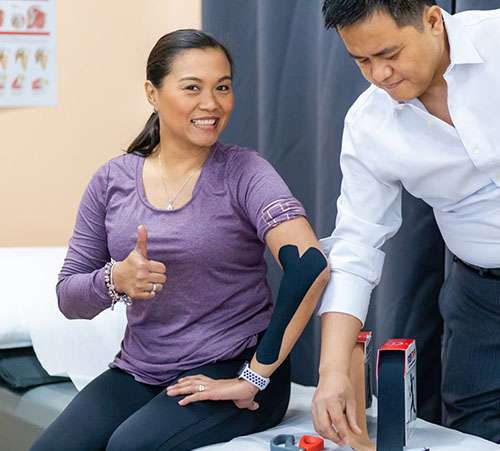Most Common Knee Conditions
-
Torn ACL
The ACL is a ligament that stabilizes the knee. It restricts the forward movement of the leg against the thigh. It also helps maintain the alignment of the joint.
Torn ACL leads to knee instability. Complete tears won’t heal. If left untreated, the knee joint can wear out fast.
Signs & Symptoms
-
1. Popping sensation during injury.
-
2. Pain and swelling.
-
3. The knee gives way during weight-bearing.
-
4. Weaken muscles.
-
5. Limited range of motion.
The Key To Recovery
-
1. Reduce Pain.
-
2. Reduce swelling.
-
3. Strengthen quads/VMO & hamstrings muscles.
-
4. Use support to help stabilize the joint.
-
5. Functional Training.
Torn Meniscus
The meniscus is cartilage that cushions the knee. It absorbs shock and improves the congruence of the joint.
A torn meniscus causes pain and swelling. Symptoms increase with weight-bearing and prevent full knee extension. Without treatment, it may worsen and lead to arthritis.
Signs & Symptoms
-
1. Pain & swelling.
-
2. Clicking sensation.
-
3. Knee locking.
-
4. Increase pain when twisting the knee.
-
5. Difficulty walking.
The Key To Recovery
-
1. Control the inflammation.
-
2. Retrain & strengthen quads muscles.
-
3. Stretch hamstrings & calf muscles.
-
4. Protect the joint.
-
5. Functional training.
Patellofemoral Pain Syndrome
The patella called the knee cap covers the front part of the knee joint. It acts as a pulley to enhance the strength of quadriceps.
Patellofemoral pain syndrome is an aching pain in the front of the knee due to overuse or injury. It is common among runners and athletes. The patella can also get off track with muscle imbalance that causes pain. If left untreated, it will lead to arthritis.
Signs & Symptoms
-
1. Aching pain at the knee cap area.
-
2. Increase pain with prolonged knee bending.
-
3. Increase pain with prolonged weight-bearing.
-
4. Difficulty negotiating stairs.
-
5. Increase pain squatting.
The Key To Recovery
-
1. Reduce pain and spasms.
-
2. Stretch tight calf, hamstrings, TFL.
-
3. Retrain and strengthen quads/VMO muscles.
-
4. Improve patellar tracking.
-
5. Gradual increase in exercises.
Runner's Knee
Iliotibial band(ITB) is a fibrous tissue that stabilizes the outer side of the knee.
Runner’s knee occurs when you overuse ITB from weight-bearing activities or injury. If left untreated, it can result in pain and irritation cycle that hurts the knee cap and the knee.
Signs & Symptoms
-
1. Knee pain.
-
2. Tender to deep pressure @ outer knee area.
-
3. Tight TFL.
-
4. Weak quads/VMO.
-
5. Increase symptoms when running or negotiating stairs.
The Key To Recovery
-
1. Control inflammation.
-
2. Loosen & stretch ITB.
-
3. Strengthen quads/VMO & adductor muscles.
-
4. Exercise to mobilize knee.
-
5. Progressive functional training.
Knee Tendonitis
The tendons are the soft tissues that connect muscles to bone. The quads & patella tendons are attached to the knee cap. Knee tendonitis is an irritation to the tendons of the knee. It can heal with proper management. If torn, it may need further intervention.
Signs & Symptoms
-
1. Aching pain at the front of the knee.
-
2. Swelling.
-
3. Stiffness
-
4. Increase pain with deep pressure.
-
5. Increase pain with running, jumping, or squatting.
The Key To Recovery
-
1. Control inflammation.
-
2. Prevent adhesions in the tendon.
-
3. Unload knee activities in the beginning.
-
4. Progressive loading of the knee as pain decreases.
-
5. Functional Training.
The Right Care Approach For Your Situation
-
-
Protective
CareOur approach to care is to protect your injury or surgery. We focus on stopping more damage to your tissues and start the healing process.The ideal method of care when you can't function due to pain and weakness. You still depend on others fully to meet your needs.Our treatment is to protect, rest, ice, compress, and elevate the injured tissue with your prescribed medications. We will also teach you home remedies.Our goal is to kick-start your recovery and prevent secondary problems. We want you to heal at the expected time.
-
-
-
Gentle
CareOur approach to care is gradual when your condition is stable but painful. Then, we focus on faster healing of your tissues and recovery of function.The ideal method when your pain is bearable, but the movement is limited. Besides, you show difficulty performing self-care and daily routine.Our treatment is heat or cold, ultrasound, and TENS combined with massages. You will start with pain-free exercises to improve your functions.Our goal is to accomplish your daily needs with no assistance. We will prepare you to regain your primary activities.
-
-
-
Progressive
CareOur approach to care is aggressive when you need to regain normal function. Our focus is training related to your daily work and active life.The choice of care when performing your daily duties is still challenging. You still have an increase in pain with increasing activities.Our treatment includes manual therapy to deal with spasms and tightness. Then, we prescribe exercises and targeted work-outs to a balanced posture.Our goal is for you to perform daily duties and hobbies without pain. Moreover, we will guide you to improve your strength without difficulty.
-
-
-
Enhance
CareOur approach to care is to maximize your performance in sports. Therefore, we focus on specific training to boost your skills in a game.The perfect method when you need to optimize your skills. It will be best to refine your balance, agility, and posture to perform better in sports.Our treatment includes taping and manual therapy to activate muscle action. In addition, you practice targeted training for specific game skills.Our goal is for you to perform well in sports and enjoy your hobbies. Thus, we will help maximize your performance in your game.
-

Physical Therapy Method of Care
Our treatment is based on the proven method of physical therapy. We use techniques tested to help our patients recover and live pain-free.
For more than 20 years of experience, the methods and healing process is almost the same for each patient. But our approach depends on their issues. Besides, we treat patients as a human, not a body part.
Our best experience for recovery is to give proper care. We have to feel what our patients feel and understand their concerns. Only then we provide the best care.
At CT Physical Therapy Care, our happiness is to give you a 5 Start experience!

Contact Us
"*" indicates required fields
-


